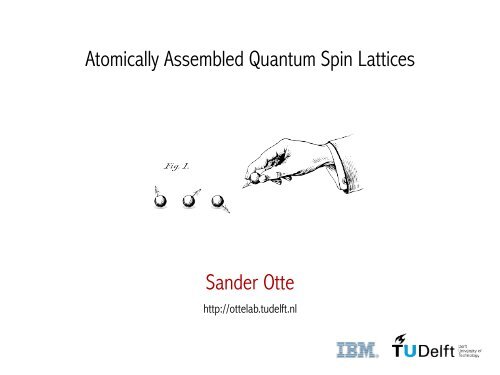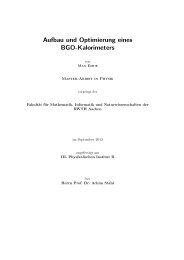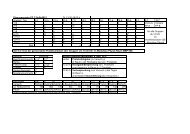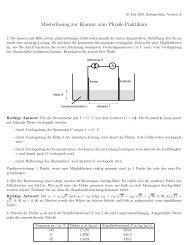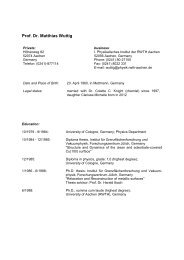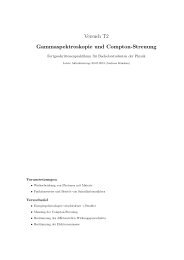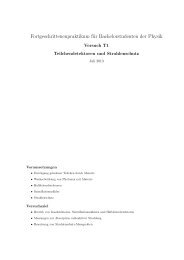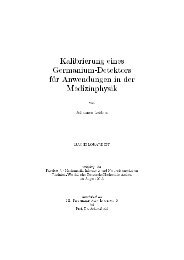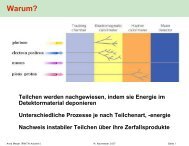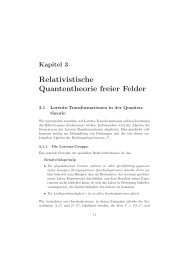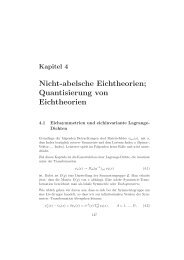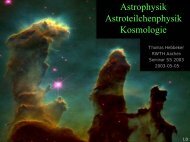Atomically Assembled Quantum Spin Lattices Sander Otte
Atomically Assembled Quantum Spin Lattices Sander Otte
Atomically Assembled Quantum Spin Lattices Sander Otte
Create successful ePaper yourself
Turn your PDF publications into a flip-book with our unique Google optimized e-Paper software.
<strong>Atomically</strong> <strong>Assembled</strong> <strong>Quantum</strong> <strong>Spin</strong> <strong>Lattices</strong><br />
<strong>Sander</strong> <strong>Otte</strong><br />
http://ottelab.tudelft.nl
<strong>Atomically</strong> <strong>Assembled</strong> <strong>Quantum</strong> <strong>Spin</strong> <strong>Lattices</strong><br />
OUTLINE<br />
1. Overview of single atom spin IETS measurements:<br />
• Magnetic anisotropy<br />
• <strong>Spin</strong> coupling<br />
• <strong>Spin</strong> pumping (spin dynamics)<br />
2. NEW: Anisotropic superexchange coupling<br />
<strong>Sander</strong> <strong>Otte</strong><br />
http://ottelab.tudelft.nl
<strong>Spin</strong>-Polarized STM<br />
Use magnetic tip in order to see magnetization direction<br />
Static, directional<br />
Inelastic Tunneling<br />
Measure energy needed to change magnetization<br />
Dynamic, non-directional<br />
Small voltage:<br />
Only elastic tunneling<br />
Larger voltage:<br />
Also inelastic tunneling<br />
Co on Pt(111)<br />
Science 320, 82 (2008)<br />
Fe on Cu 2 N/Cu(100)<br />
© 2012 <strong>Sander</strong> <strong>Otte</strong> http://ottelab.tudelft.nl
vacancy direction <br />
Magnetic Anisotropy<br />
Magnetic field along nitrogen direction<br />
Magnetic field along vacancy direction<br />
0.36 nm <br />
nitrogen direction <br />
Cu 2 N on Cu(100) <br />
© 2012 <strong>Sander</strong> <strong>Otte</strong> http://ottelab.tudelft.nl
vacancy direction <br />
Magnetic Anisotropy<br />
Magnetic field along nitrogen direction<br />
Magnetic field along vacancy direction<br />
Ĥ = gµ B B · Ŝ + DŜ2 z + E<br />
⇣Ŝ2 x Ŝ 2 y<br />
⌘<br />
D < 0 means easy-axis anisotropy<br />
0<br />
• <strong>Spin</strong> prefers the z-axis for magnetization<br />
1 -1<br />
• Ground state has large |m z |<br />
2<br />
-2<br />
D > 0 means hard-axis anisotropy<br />
• <strong>Spin</strong> dislikes the z-axis for magnetization<br />
• Ground state has small |m z |<br />
2<br />
1 -1<br />
0<br />
-2<br />
nitrogen direction <br />
© 2012 <strong>Sander</strong> <strong>Otte</strong> http://ottelab.tudelft.nl
Magnetic Anisotropy<br />
Magnetic field along nitrogen direction<br />
Magnetic field along vacancy direction<br />
Magnetic field along vacancy direction<br />
Ĥ = gµ B B · Ŝ + DŜ2 z + E<br />
⇣Ŝ2 x Ŝ 2 y<br />
⌘<br />
For Fe: S = 2, D = −1.55 meV, E = 0.31 meV, g = 2.11<br />
D < 0 means easy-axis anisotropy<br />
0<br />
• <strong>Spin</strong> prefers the z-axis for magnetization<br />
1 -1<br />
• Ground state has large |m z |<br />
2<br />
-2<br />
along nitrogen direction <br />
D > 0 means hard-axis anisotropy<br />
2<br />
-2<br />
• <strong>Spin</strong> dislikes the z-axis for magnetization<br />
1 -1<br />
• Ground state has small |m z |<br />
0<br />
Hirjibehedin et al. Science 317, 1199 (2007)<br />
© 2012 <strong>Sander</strong> <strong>Otte</strong> http://ottelab.tudelft.nl
<strong>Spin</strong> Coupling<br />
1 Mn <br />
10 Mn <br />
Hirjibehedin et al. Science 312, 1022 (2006)<br />
0.36 nm<br />
Strong coupling<br />
• Atoms not discernable in topography<br />
• Cannot be taken apart<br />
• <strong>Spin</strong>s combine into one state: |S total , M total 〉<br />
<strong>Otte</strong> et al. PRL 103, 107203 (2009)<br />
0.72 nm<br />
Weak coupling<br />
• Atoms discernable in topography<br />
• Can be taken apart<br />
• <strong>Spin</strong>s remain separate: |s 1 , s 2 , m 1 , m 2 〉<br />
© 2012 <strong>Sander</strong> <strong>Otte</strong> http://ottelab.tudelft.nl
<strong>Spin</strong> Coupling<br />
On a single Co atom:<br />
Kondo resonance splitting in magnetic field<br />
<strong>Otte</strong> et al. Nature Physics 4, 847 (2008)<br />
Magnetic field along vacancy direction<br />
7 T<br />
5 T<br />
3 T<br />
<strong>Otte</strong> et al. PRL 103, 107203 (2009)<br />
Magnetic field along nitrogen direction<br />
7 T<br />
5 T<br />
3 T<br />
-5 0 5<br />
1 T<br />
0 T<br />
0.72 nm<br />
J = 0.13 meV (AF coupling)<br />
-5 0 5<br />
1 T<br />
0 T<br />
© 2012 <strong>Sander</strong> <strong>Otte</strong> http://ottelab.tudelft.nl
<strong>Spin</strong> Coupling<br />
DFT calculation along<br />
nitrogen direction:<br />
Hirjibehedin et al. Science 317, 1199 (2007)<br />
Strong coupling due to<br />
covalent surface network<br />
Magnetic field along vacancy direction<br />
7 T<br />
5 T<br />
3 T<br />
1 T<br />
<strong>Otte</strong> et al. PRL 103, 107203 (2009)<br />
Magnetic field along nitrogen direction<br />
7 T<br />
5 T<br />
3 T<br />
1 T<br />
-5 0 5<br />
0 T<br />
J = 0.13 meV (AF coupling)<br />
-5 0 5<br />
0 T<br />
© 2012 <strong>Sander</strong> <strong>Otte</strong> http://ottelab.tudelft.nl
<strong>Spin</strong>-Polarized STM<br />
Use magnetic tip in order to see magnetization direction<br />
Static, directional<br />
<strong>Spin</strong> Pumping<br />
Use magnetic tip to control magnetization direction<br />
Dynamic, directional<br />
Inelastic Tunneling<br />
Measure energy needed to change magnetization<br />
Dynamic, non-directional<br />
−5/2<br />
−3/2<br />
−1/2<br />
+1/2<br />
+3/2<br />
+5/2<br />
0.7 meV<br />
B = 7 T <br />
B = 7 T <br />
Low current High current<br />
−5/2<br />
−3/2<br />
−1/2<br />
+1/2<br />
+3/2<br />
+5/2<br />
For Mn: S = 5/2, D = −0.04 meV<br />
At 7 T this results in a simple ladder<br />
x!<br />
© 2012 <strong>Sander</strong> <strong>Otte</strong> http://ottelab.tudelft.nl<br />
Loth et al. Nature Physics 6, 340 (2010)
Pump-probe Pulsing<br />
• Pump pulse exceeds excitation threshold voltage<br />
• Probe pulse stays well below threshold<br />
• Measure DC as a function of the delay time Δt<br />
Loth et al. Science 329, 1628 (2010)<br />
T 1 = 86 ns<br />
© 2012 <strong>Sander</strong> <strong>Otte</strong> http://ottelab.tudelft.nl
3<br />
He STM system in Delft<br />
300 mK, 10 -10 mbar, 9T/2T
Constructing spin lattices<br />
Aims:<br />
• Construct 1D and 2D spin lattices<br />
• Tune J by adjusting atom spacing<br />
• Search for quantum phase transitions<br />
• Explore non-trivial magnetization states<br />
(frustration, spin liquids, …)<br />
• Build Kondo chains/lattices<br />
Similar to:<br />
Loth et al., Science 335, 196 (2012)<br />
© 2012 <strong>Sander</strong> <strong>Otte</strong> http://ottelab.tudelft.nl
Acknowledgements<br />
Andreas Heinrich (IBM Almaden)<br />
Chris Lutz (IBM Almaden)<br />
Cyrus Hirjibehedin (UCL, London)<br />
Markus Ternes (MPI Stuttgart)<br />
Kirsten von Bergmann (Universität Hamburg)<br />
Sebastian Loth (CFEL, Hamburg)<br />
Harald Brune (EPFL, Lausanne)<br />
Barbara Jones (IBM Almaden)<br />
Don Eigler (IBM Almaden)<br />
The <strong>Otte</strong> Lab in Delft:<br />
Anna <strong>Spin</strong>elli<br />
Ben Bryant<br />
PhD positions available!<br />
© 2012 <strong>Sander</strong> <strong>Otte</strong> http://ottelab.tudelft.nl


